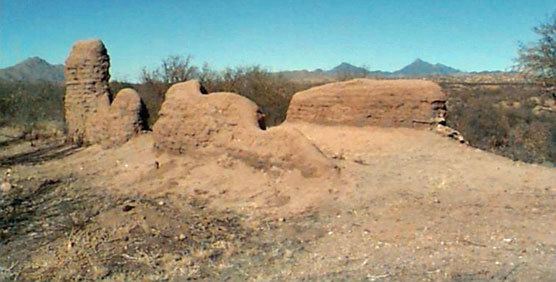Year built 1751 Nearest city Nogales | Founding date 1701 Added to NRHP 5 November 1971 | |
 | ||
Name as founded La Misión de San Gabriel de Guevavi English translation The Mission of Saint Gabriel of the Big Spring Founding priest(s) Father Eusebio Francisco KinoFather Salvatierra Similar Tumacácori National Historical, Tubac Presidio State Hist, San Xavier del Bac, Presidio San Augustin, Hohokam Pima National | ||
Mission Los Santos Ángeles de Guevavi (O'odham: Geʼe Wawhia) was founded by Jesuit missionary Fathers Kino and Salvatierra in 1691 as La Misión de San Gabriel de Guevavi, a district headquarters in what is now Arizona, near Tumacácori. Subsequent missionaries called it San Rafael and San Miguel, resulting in the common historical name of Los Santos Ángeles de Guevavi.
Contents
History
Father Juan de San Martin was assigned as the first resident priest (he left in 1703), with construction of a small chapel in 1701. Guevavi was designated as cabecera (headquarters) that same year. The ruins of the mission church are situated amidst a native Sobaipuri or O'odham (Upper Pima) settlement. Fathers Agustín de Campos and Luis Xavier Velarde visited occasionally after that. Father Grazhoffer reestablished a second church Guevavi in 1732.
In 1751, Father Garrucho contracted the building of a new and larger 15 foot by 50 foot church, the ruins of which still exist today. The mother of Juan Bautista de Anza is buried in front of the altar. By the late 1690s, the Mission consisted of a church, a carpentry shop, and a blacksmith's area. By the 1770s, the settlement had been abandoned. The first Franciscan priest, Father Juan Crisóstomo Gil de Bernabé, arrived in 1768 and took up residency at the Mission with about fifty families. The Apaches attacked in 1769 and killed all but two of the few Spanish soldiers guarding the Mission; in 1770 and 1771 the natives continued their attacks and the cabecera was relocated to Tumacácori. Mission Los Santos Ángeles de Guevavi was abandoned for the last time in 1775.
Archaeology
The convento and church have been excavated by the Arizona Archaeological and Historical Society and the National Park Service. Historian John Kessell has written a comprehensive history of Guevavi. Archaeologist Deni Seymour has excavated a portion of the indigenous Sobaipuri-O'odham settlement of Guevavi and Father Kino's "neat little house and church."
Tumacácori National Historical Park
The Mission's ruins were incorporated into Tumacácori National Historical Park in 1990. It was declared a National Historic Landmark in 1990.,
Juan Bautista de Anza National Historic Trail
The Mission Los Santos Ángeles de Guevavi is one of the designated tour sights of the Juan Bautista de Anza National Historic Trail, a National Park Service unit in the United States National Historic Trail and National Millennium Trail programs. A Brochure Map for driving and detailed Anza Maps by County, with a Historical destinations-events Guide and the official NPS: Juan Bautista de Anza National Historic Trail website are all available for information about the historic 1776 Juan Bautista de Anza trail places. Here, in front of the altar the mother of Juan Bautista de Anza is buried.
